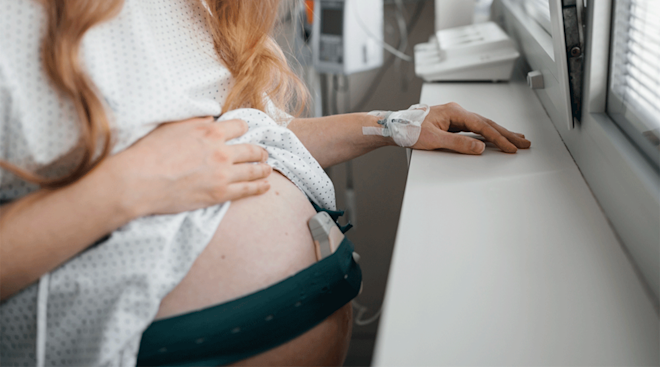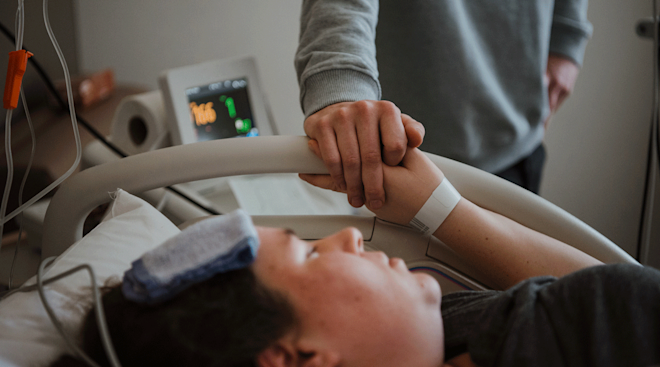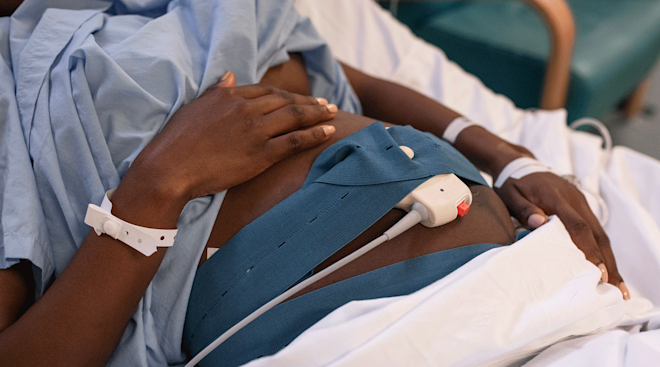What You Need to Know About VBAC (Vaginal Birth After Cesarean)
For Mari Melby, a Denver-based childbirth educator and doula, the birth of her first child two-and-a-half years ago was confusing. She had planned to have a natural childbirth in a birth center, but at 37-and-a-half weeks pregnant, she had to be induced because of her high blood pressure. Some 61 hours later, after laboring for 12 hours and then having her contractions stop completely, her practitioners made the call for a c-section. To this day, it is unclear why her baby didn’t descend.
“I was pretty crushed by the experience. It wasn’t going as planned and I had a lot of questions. No one could tell me why he didn’t come out,” says Melby, who gave birth to a boy. “That was the most disappointing part of having an unplanned c-section—wondering if there was something wrong with my body or me, that there was something I couldn’t do with my body that other women could.”
Fast forward two years, and, pregnant with a girl and living in a new city (Minneapolis), Melby was determined to have a successful VBAC. What is a VBAC? It stands for vaginal birth after cesarean—and the first challenge for Melby and any other woman attempting a VBAC is finding a provider who would allow her to try for one in the first place.
Like Melby, if you had a c-section when delivering your first child, you have two choices about how to give birth again: a scheduled c-section or a VBAC. While most practitioners today hardly bat an eye when mothers opt for a repeat c-section, it can be really hard—depending on where you live—to find one willing to allow you to attempt a VBAC. This planned attempt is called a TOLAC—a trial of labor after cesarean; a successful TOLAC results in a VBAC.
Why the difficulty in finding a practitioner willing to help women trying for a VBAC? For most of the 20th century, the general belief was that once a woman had undergone a cesarean delivery, her future pregnancies would require c-sections. The tide turned a bit in 1980, when a National Institutes of Health Consensus Development Conference Panel questioned the necessity of routine repeat cesareans.
“By 1995 the TOLAC rate had increased to approximately 52 percent,” says Yvonne Butler Tobah, MD, an ob-gyn at the Mayo Clinic in Rochester, Minnesota. “Unfortunately, there was also an increase in the rates of uterine rupture—when your uterus tears during labor, typically at the site of your prior cesarean scar, resulting in serious injury to mothers and their babies. Because of this, the American College of Obstetricians and Gynecologists recommended that attempts at a VBAC could be offered only if obstetric providers are immediately available to provide emergency care.”
TOLAC (and therefore VBAC) rates declined while those of c-sections skyrocketed, because “doctors were less likely to offer TOLAC to patients because of fear of the potential complications associated with VBAC, concerns about medical liability, and/or they couldn’t comply with the recommendation of being ‘immediately’ available if an emergency occurs,” Butler Tobah says.
That’s how we got to where we are today, where 1 in 3 births happen via cesarean. According to the National Institutes of Health (NIH), VBAC rates vary by ethnic status, medical condition, region of the country, provider and type and location of hospital. “Various surveys have revealed that since 1996, approximately one-third of hospitals and one-half of physicians no longer offer trial of labor,” a 2010 NIH report stated. “A survey of American College of Obstetricians and Gynecologists Fellows showed that, between 2003 and 2006, 26 percent stopped offering a trial of labor for women with a history of cesarean deliveries, regardless of prior vaginal delivery experience.”
Lack of access to VBACs is frustrating for many women who want the chance to deliver naturally but often feel pushed into having a c-section, which comes with the risks of major surgery: blood loss, infection, blood clots in the legs, injury to internal organs, fluid in baby’s lungs, bad reactions to anesthesia and a longer recovery time. Women who have c-sections are generally treated with more pain medication than those who deliver vaginally. C-section patients also have a longer hospital stay—two to three days, on average, as opposed to one to two.
The biggest VBAC risk mothers face when opting for this delivery method is failure of labor. The factors that cause a trial of labor to fail include:
- The baby doesn’t descend
- The baby’s heart rate falls
- There’s too much bleeding
- The uterus ruptures
Uterine ruptures with a VBAC attempt are rare—the NIH has estimated that rupture occurs in approximately 325 per 100,000 women attempting a VBAC—but they can be hard to detect. Some of the signs practitioners watch for during an attempted VBAC include: “Does the mom have sudden pain with vomiting? A fetal heart rate that suddenly goes very low? Or is there loss of station, where the baby’s head is there, it’s there, it’s there … and suddenly, there’s nothing there?” says Lynne Gibeau, MD, a staff physician at The Mother Baby Center/Abbott Northwestern Hospital in Minneapolis.
If your OB suspects a rupture while attempting a VBAC—or if any of the other factors above happen—you’ll be rushed into an operating room for a c-section, which brings about additional risks. In fact, while a successful VBAC has fewer complications than an elective repeat c-section, a c-section resulting from an unsuccessful VBAC has more risks than an elective repeat cesarean. The additional concerns that come from a repeat c-section after a VBAC include:
• Less time to react to an emergency. Already, a repeat c-section will take more time than your first. “It will take longer trying to go through all that scar tissue—sometimes you can stretch it, sometimes you have to cut it; some things have scarred in unusual places,” Gibeau says. “It’s hard to do that quickly.” Now add to that the fact that you still need to be run down the hall from the delivery room into the OR. “The best-case scenario is that we’re starting in five minutes—those are five critical minutes [and maybe] I don’t have time to make sure I’m not damaging the bladder.” If you’re doing an emergency c-section and you’ve had abnormal fetal heart rate tracing—if it might be a rupture, if the baby is partially extruded or if the umbilical cord is compressed—every single minute counts.
• Higher risk of bleeding complications. If the mother has been laboring for a long time, Butler Tobah says, “the uterus is typically softer, the baby may be very low in the pelvis and the surgical planes may not be as well defined. The bladder may be full and the uterus may be less likely to contract,” she says. “This places the mother at risk for postpartum hemorrhage after her cesarean delivery.”
Despite these risks (and the fact that you may have to sign a waiver stating that you understand that a VBAC can be riskier for your baby than a repeat c-section under certain circumstances), success rates of trial of labor are consistently high, ranging from 60 to 80 percent, according to the NIH. The checklist that most practitioners use to determine your odds for an effective VBAC is universal:
• You had a low-transverse incision (a bikini cut) during your c-section, which is less likely than a vertical cut to rupture during labor.
• You don’t have any medical conditions (hypertension, obesity) that make vaginal delivery risky.
• The hospital where you’re planning to deliver is equipped to deal with any emergencies that arise during an attempted VBAC (i.e., has immediate access to an anesthesiologist).
Sometimes, like with Melby, the reasons why you went through a c-section the first time aren’t so clear cut, which can lower your odds of finding a practitioner willing to consider a VBAC. “The surgical note from [my previous] hospital wasn’t very helpful,” she says. “It didn’t piece things together and there were lots of inconsistencies in terms of how far down did [the baby] get and what positions was he in. As a result, I saw a lot of providers and it was very inconsistent with what my odds would be.”
When picking a provider for a VBAC—the most important piece of your VBAC plan, says Melby, who ended up having a successful VBAC in March 2017—you want to look for someone who gives you a very clear answer on VBAC and who has a strong record of VBAC success.
And remember, even if all the research around VBAC safety and VBAC risks makes it a yes for you on paper, you still have to ask yourself if a VBAC is the safest emotional choice for you. “If you feel like you can’t do it, if your first birth was so traumatic that you can’t face the idea of laboring and having it fail, if [all this] would destroy you—don’t do it,” Melby says. “Thinking about your own emotional health and your well-being as part of the equation is really important.”
Updated October 2017
Please note: The Bump and the materials and information it contains are not intended to, and do not constitute, medical or other health advice or diagnosis and should not be used as such. You should always consult with a qualified physician or health professional about your specific circumstances.
Navigate forward to interact with the calendar and select a date. Press the question mark key to get the keyboard shortcuts for changing dates.




















































